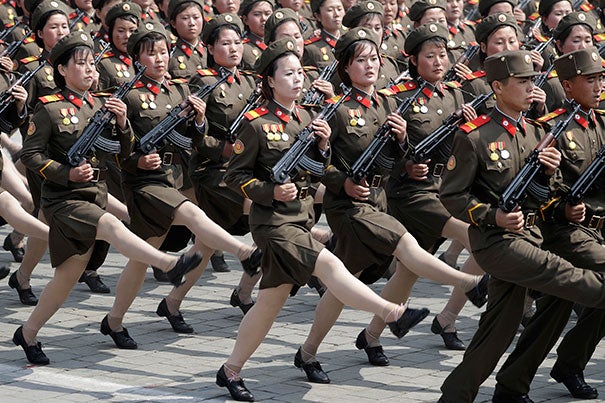North Korea’s Nuclear Program: Latest Developments
5 min read
North Korea has been in the news lately for its nuclear program. North Korea has been developing a nuclear program for many years, and it appears that they are making progress. Recently, North Korea has tested a new type of missile, which some experts say is a step toward developing a nuclear weapon. North Korea is a member of the United Nations, and it is illegal for them to develop nuclear weapons. The United Nations Security Council has passed several resolutions calling for North Korea to stop its nuclear program, but so far, they have not complied. North Korea is a very isolated country, and it is difficult to get information about its nuclear program. However, experts believe that North Korea is making progress in developing nuclear weapons.
1. North Korea’s Nuclear Program: Latest Developments
In recent years, North Korea’s nuclear program has made headlines around the world. The country’s continued development of nuclear weapons and missiles has led to increased tensions with the United States and its allies. Here are the latest developments in North Korea’s nuclear program.
In December of 2017, North Korea announced that it had successfully tested a new type of intercontinental ballistic missile (ICBM). The missile, known as the Hwasong-15, is said to be capable of reaching any target in the continental United States. This latest test came just a few months after North Korea fired a missile over Japan, prompting international condemnation.
In response to North Korea’s continued nuclear development, the United Nations Security Council has imposed a series of sanctions on the country. These sanctions are designed to put economic pressure on North Korea in an effort to get them to stop their nuclear program. So far, these sanctions have not had the desired effect, and North Korea continues to work on its nuclear weapons.
In April 2018, North Korea announced that it was suspending its nuclear and missile tests. This was seen as a positive step by the international community, but it is unclear if North Korea will stick to this promise. Time will tell if North Korea is truly committed to denuclearization, or if this is just a ploy to ease international tensions.
The latest developments in North Korea’s nuclear program are sure to continue to be a major concern for the international community. It remains to be seen if North Korea will give up its nuclear ambitions, or if they will continue to develop these weapons despite the risks.
2. North Korea’s Nuclear Program: A Brief History
Since the 1950s, North Korea has been developing nuclear weapons. In the early 1990s, the country was close to building an atomic bomb. But it agreed to stop its nuclear program in exchange for economic aid.
In 2002, North Korea admitted that it had been secretly developing nuclear weapons again. The United States then stopped providing economic aid. In 2006, North Korea conducted its first nuclear test. Since then, it has conducted five more nuclear tests.
In 2016, North Korea claimed to have developed a nuclear weapon that could be mounted on a ballistic missile. This claim has not been verified. But experts believe that North Korea now has the ability to build a nuclear bomb.
In 2017, North Korea conducted several missile tests. In August, it fired a missile over Japan. In September, it conducted its sixth nuclear test. This was its most powerful nuclear test to date.
In 2018, North Korea held talks with the United States and South Korea. It agreed to stop its nuclear and missile tests. It also agreed to close one of its nuclear facilities. But North Korea has not kept its promises. It has continued to test missiles. And it is believed to be continuing its nuclear program.
The United States is now working to get North Korea to agree to give up its nuclear weapons. But it is not clear if North Korea will ever agree to do this.
3. North Korea’s Nuclear Program: Current Status
Since the early 1990s, North Korea has been developing nuclear weapons. In 2006, it conducted its first nuclear test, and in 2009 it was revealed that the country had developed a nuclear weapon small enough to be delivered by a missile. In 2013, North Korea conducted its third nuclear test, and in 2016 it claimed to have developed a hydrogen bomb.
In 2017, North Korea conducted its sixth and most powerful nuclear test to date, and in November of that year, it launched its most powerful ballistic missile yet, the Hwasong-15. This led to increased international pressure on the country, and in 2018 North Korea began to take steps toward denuclearization. However, progress has been slow, and in 2019 North Korea conducted several short-range missile tests.
As of 2020, North Korea is believed to have a small arsenal of nuclear weapons, and it is continuing to work on its missiles and nuclear weapons program. The country has not yet carried out a nuclear test since 2017, but it is still considered a nuclear threat.
4. North Korea’s Nuclear Program: Future Prospects
Since the early 2000s, North Korea has been working to develop a nuclear weapons program. In 2006, the country conducted its first nuclear test and has since conducted five more. In 2017, North Korea also began testing intercontinental ballistic missiles (ICBMs), which could potentially be used to deliver a nuclear weapon to the United States.
Despite international condemnation and multiple UN Security Council resolutions, North Korea has continued to pursue its nuclear program. In January 2018, North Korean leader Kim Jong-un announced that the country was in the final stages of developing a nuclear weapon that could be mounted on an ICBM.
The future of North Korea’s nuclear program is uncertain, but there are a number of potential scenarios.
One possibility is that North Korea continues to develop its nuclear capabilities, in defiance of international pressure. In this scenario, North Korea could eventually succeed in developing a nuclear weapon that could be used against the United States or its allies.
Another possibility is that North Korea agrees to denuclearize, in exchange for concessions from the United States and its allies. This could involve North Korea dismantling its nuclear program in return for economic aid and security guarantees.
A third possibility is that North Korea’s nuclear program is destroyed through military action. This could occur if the United States or its allies launch a preemptive strike against North Korea, in an attempt to disable its nuclear capabilities.
Whatever the future holds for North Korea’s nuclear program, it is clear that the country’s nuclear ambitions are a major source of concern for the international community.






